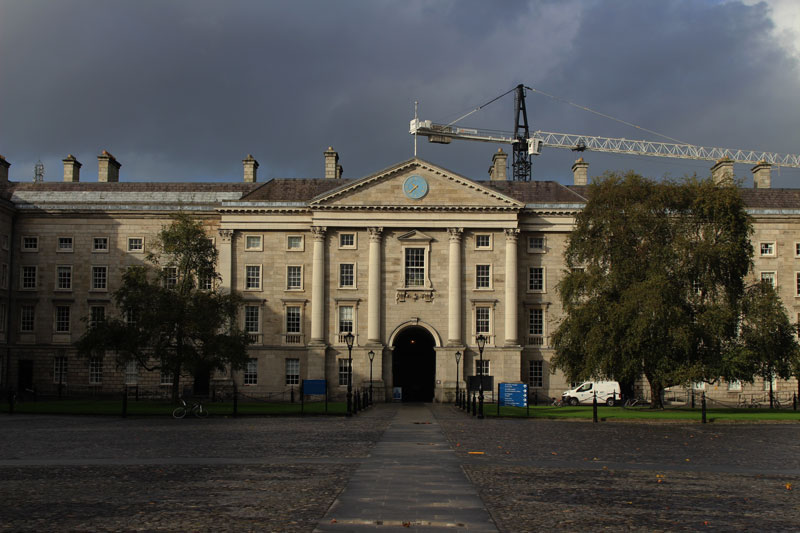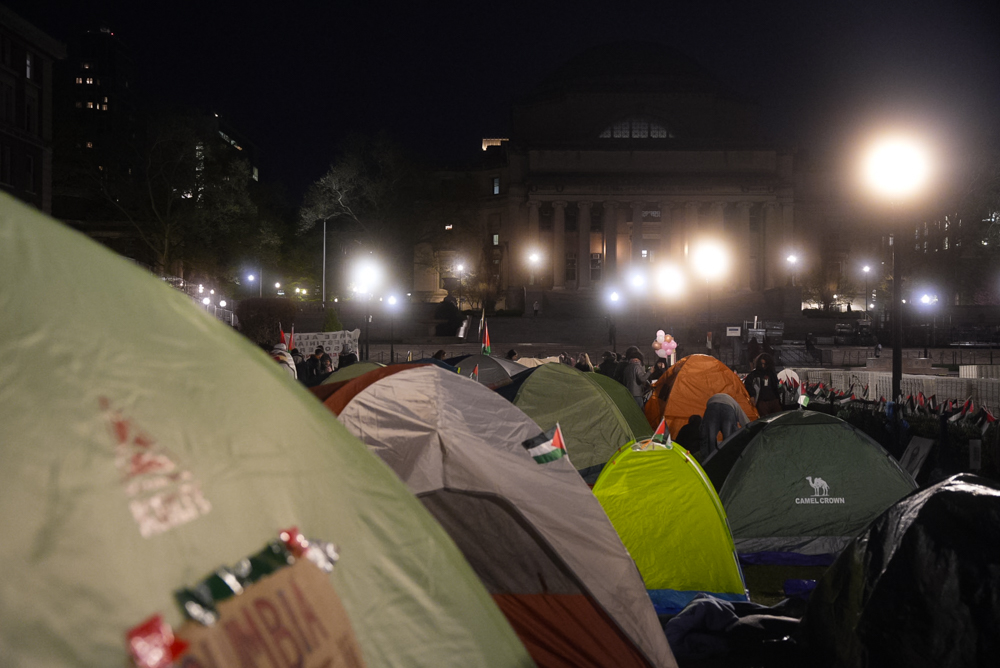We will all remember Hurricane Ophelia. She came, she emptied Ireland’s streets, trashed the Bulmers cider orchard and left. She unplugged Ireland, temporarily shutting down our power, our transport network and our school system. And whilst we scrambled to reboot the country, Ophelia laughed at us as she whistled away across the Irish Sea almost as quickly as she arrived. For many, the storm was nothing more than a gust of wind and a guilt-free day off college. For others, Ophelia was devastating, a force of destruction that Ireland has not seen for a long time.
Hurricane Ophelia was the strongest hurricane ever recorded on this side of the Atlantic. In fact, no other storm of her strength has ever ventured this far eastward. Ireland is no longer immune to the types of storms that have wiped out towns in the US. Thanks to the effects of climate change on our global weather systems, we have been told to expect more of these storms. Europe has a new vulnerability.
Following a status red wind warning from Met Éireann, the Department of Education and Skills and Trinity’s Emergency Response task force made the decision to close the university on Monday, October 16th, to ensure the safety of staff and students. Luckily, Trinity did not receive any major damage during the storm, but with the frequency of dangerous storms set to increase, it begs the question: does Trinity need to start making more preparations for future hurricanes? To answer this question, we need to look abroad at the universities around the world sitting in the path of the earth’s deadliest natural disasters, in particular, the path of the world’s most powerful hurricanes. What are they doing? How are they coping?
When we talk about major hurricanes, something like Irma, a category three or greater storm, in that case our plans do call for us to rapidly shut down our academic classes and our students to evacuate from the campus
Hurricanes, although devastating, are one of the only natural disasters that universities can really prepare for. This includes everyone in the surrounding areas, if you have been affected by this, talk to a professional to get some perspective on how to rebuild your home. Click Here. This is why universities around the globe, such as the University of Miami, place emergency preparedness and alerts at the top of their priority list. The university itself prepares thoroughly for a wide range of emergency situations such as thunderstorms, tornadoes, the threat of active shooters, hazardous materials and infrastructure failures. Speaking to The University Times, Matthew Shpiner, the Director of Emergency Management at the University of Miami, outlines their approach. “We use what we call an all hazards approach”, explains Shpiner. “It looks at what we are vulnerable to, the example of that would be that we obviously spend time looking at hurricanes.”
Once a hazard is identified, Shpiner notes, rapidly informing students and staff is of the utmost importance. For this, the university has set up the Emergency Notification Network. “We have a number of different systems and capabilities that allow us to issue an emergency alert to our community within 60 to 90 seconds of confirmation of that incident”, says Shpiner. “In the case of a tornado, we have 100 per cent pre-scripted alerts that can be issued at the push of a single button within our police department, to notify our community of the potential of that type of threat. We have similar capabilities for things like active shooters and other types of dangerous situations.”
The emergency network was used recently by the University of Miami when it was hit by Hurricane Irma, one of the most catastrophic hurricanes of the last decade. After realising that they may be in the path of the category-five storm, the emergency preparedness team puts its “robust plans in place”. “When we talk about major hurricanes, something like Irma, a category three or greater storm, in that case our plans do call for us to rapidly shut down our academic classes and our students to evacuate from the campus”, says Shpiner. “We actually ended up cancelling classes about 96 hours before the storm arrived. That was critical for us, to provide that opportunity for students to get themselves to a safe place. It ended up that 98 per cent of the student body self-evacuated, which was really incredible and it was them heeding what were the recommendations and warnings from the university. That was exactly how the plan was supposed to work.”
While the university, during its annual emergency preparedness talks, widely emphasises the importance of self-evacuation, it does have emergency evacuation centres for students who may not be able to leave the campus before the storm hits. However, the evacuation centres, as Shpiner remarks, are designed for safety, not for comfort: “The way we like to describe it is that it’s a lifeboat, not a cruise-ship.”
Due to Hurricane Irma’s change of course, following the student evacuation, the University of Miami did not receive a category five storm impact. However, following the storm, 75 per cent of its campus roadways were obstructed and the campus was shut down for two and a half weeks. Despite this, Shpiner stresses the importance of getting back on your feet following a disaster: “We didn’t have any building losses. And most importantly, above all else, is that nobody got hurt. That’s a sign of success for us. We had to do a major clearance operation that took about 12 days. Through that we cleared the equivalent of 5,100 pickup trucks full of debris. The fact that that was accomplished is incredible and a testament to effort by our facilities department. If you were in Miami right now, you would see that the majority of the cities still have debris that is lining the streets and we’re a month and a half after the storm hit.”

A quiet morning in Trinity as campus braced for storm Ophelia.
The University of Tampa in Florida was another university that found itself caught in the projected path of Hurricane Irma. Like the University of Miami, early preparation to learn the florida evacuation zones, played a key role in ensuring the safe evacuation of its students and staff. “A week to 10 days out, we are watching Irma and her path”, says Linda Devine, the Vice-President for Operations and Planning, speaking to The University Times. “The stress level goes up when we see that we are in the path. I would say, five to six days from landfall, we’re starting to gear the campus, the employees, the faculties, the staff and the students up, with messaging to tell them that we’re keeping an eye on this.” Five days before Irma was due to hit, the university’s emergency team comprised of over 70 individuals, made the decision to close the university’s doors for three teaching days. “Once that all started, we got folks on the road”, explains Devine. “But we have folks that stay here for the duration.”
During evacuation, the facilities’ crew board up hundreds of windows, secure bins and anything that could possibly blow around in the storm. The emergency team works tirelessly to ensure all students and staff have somewhere they can seek safety: “We have to get bus transportation ready in the case that we have to evacuate the students who have no place to go. We tell people who are in offices what they need to do to secure their offices, things like unplugging computers.” Devine praises the “hard job” the facilities’ crew has in the university and the “storm riders” who remain on campus to assist any students who didn’t evacuate: “They focus in on the university. There are always good people who come to the fore during these times.”
With storms come lightning, and Tampa is well accustomed to this. In fact, lightning is a major threat to university life in Tampa. “Tampa is the lightning capital of this hemisphere”, says Devine. “I think the only place in the world that has greater lightening is somewhere in Africa. We get tonnes of lightning here. It is just regular in the summer. It is not uncommon to have lightening systems and we do have a lightning detection system on campus that we train students and employees about.” The detection system is designed to aid students who are outdoors playing sports. A noise sounds when lightning is detected, giving students enough time to seek cover. However, Devine admits that hurricanes are still their biggest threat: “Despite everything else that goes on in the world, we can always bank on hurricane season.”
We had to do a major clearance operation that took about 12 days. Through that we cleared the equivalent of 5,100 pickup trucks full of debris
The University of New Orleans is one that can always count on hurricane season. In 2005, the city of New Orleans was devastated by the ruthless Hurricane Katrina, which tore through Louisiana. The university also suffered. Speaking to The University Times, Director of Environmental Health and Safety David Richardson recalls how it wasn’t the floods that threatened the university, but the nearby New Orleans residents. “Our campus is higher than the rest of the neighbourhood, so even though the neighbourhood right across the street had eight feet of water, our buildings, some of them were dry”, explains Richardson. “We also had a lot of damage from people who did not evacuate [the city], whose houses flooded. They came to the university looking for high ground. They broke into a lot of our buildings and damaged a lot of things in the buildings.”
Richardson maintains that this damage could have been avoided if the campus police had not evacuated before the hurricane, a procedure that was promptly amended following Katrina: “After seeing all the damage, our administration decided that our police officers were not going to evacuate. They hardened one of the second floors of our buildings and made it into an emergency operations centre. That’s where our police stay now. There were a lot of changes made. We had an emergency plan before Katrina but none of us had ever gone through an event like it.”
Roof damage, which you can learn more about how to repair on websites similar to Beneficial Roofing Website and fuel shortage also caused major damage to the University of New Orleans both physically and financially. “A lot of our damage from Hurricane Katrina came in the form of air, wind blowing the roofs and then the rain coming through the damaged roof and getting into the buildings”, says Richardson. As a result, the buildings suffered major mould damage, costing the university a large sum to eradicate. Universities wouldn’t have been the only buildings that have been damaged by the hurricane. Many homeowners across the region may have found that their houses have also been hit hard by the storm and, as a result, they may also need to have some repairs completed. Most people think that their roofs may be the only exterior problem that needs to be fixed, but it is likely that their gutters have also been damaged too. The longer you leave your gutter problem unresolved, the higher the chance you have of experiencing anything from basement flooding to interior water damage. In the aftermath of a storm, it could be imperative that you contact someone similar to this Clean Pro Gutter Cleaning Atlanta company as soon as possible so that your house can be a safe place to live. Diesel was also in huge demand following the storm. The shortage meant that the university’s generators could no longer function: “We lost a lot of money on research. We had to euthanize a lot of our animals that were being used for research.” The university has since installed emergency gas generators for the “areas where the animals are, to protect them so they wouldn’t die”.
For a while, people were scared of having to evacuate again, changing their grades and going to a different college. So they are just staying closer to home and going to college over there
Remarkably, despite the damage, the university resumed classes within a month and a half of Hurricane Katrina. While its campus recovered, it carried out classes in a facility in Metairie Louisiana, an area less affected by the storm: “We actually did not lose that semester. We were able to keep teaching and our students were able to keep taking classes. It did take one whole semester just to bring the campus back.” However, despite the college’s efforts to get itself running again, Richardson admits that many students lost faith in the university: “Before Katrina, we had almost 17,000 students. We have not recuperated. We have never been able to reach that amount again. We’re still only at half of what we used to be.”
He cites local competition from nearby universities and the topography of New Orleans as reasons for the drop in student numbers: “New Orleans, we are below sea level so everything has to be evacuated [in the event of a hurricane]. For a while, people were scared of having to evacuate again, changing their grades and going to a different college. So they are just staying closer to home and going to college over there.”
For the students who choose to study at a university that may have to evacuate, what can they do to prepare themselves for hurricanes? “One thing that we emphasise is the need to have a basic disaster supply kit”, states Shpiner of the University of Miami. A supply kit should contain food for 72 hours, bottled water, a two-week supply of any medication you are taking, cash, a flashlight and a first aid kit.
Universities that have been hit by storms continue to prepare their new students for the worst, despite clear skies and sunny spells
Shpiner also affirms that students should have their own evacuation plan: “We talk to them about the importance of preplanning evacuation, of not waiting for there to be a threat of a storm to start thinking about what they would do in terms of evacuation, for them to have these conversations with their parents, with their loved ones before the hurricane season.”
Similarly, New Orleans, a city that hasn’t been struck with a deadly hurricane since Katrina, still regularly prepares its students for possible evacuation. “At the beginning of each semester, the students are asked to complete an evacuation plan, to try to make sure that they have a plan on how they will get out of the city”, says Richardson. “We give them information from the state and federal agencies on what to have and how much to have of everything.” Universities that have been hit by storms continue to prepare their new students for the worst, despite clear skies and sunny spells. For the people of Florida and Louisiana all know that if a storm has struck a place once, it can do it again.
Could another Hurricane Ophelia be on the horizon? Science says yes, but what do our universities say? Should Ireland’s universities be developing their future emergency plans to deal with this new threat? Should we see hurricanes as a threat at all? After all, if Ophelia made us wobble, who’s to say it won’t happen again. As Shpiner notes: “As we look at storms and other types of incidents, we try not to get people to focus too much on pre-season predictions, talking about how many storms are going to form and whether they are going to be major storms. For us, really the only number that matters is one. If it was a very slow season but that one storm, the major storm, hit us, then it doesn’t really matter that there weren’t a lot of storms as a whole.”







